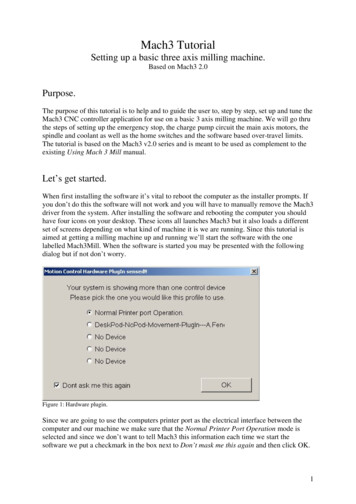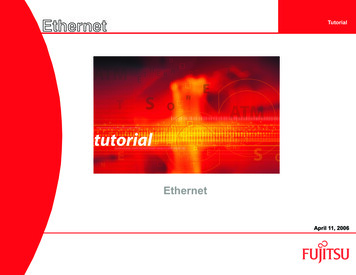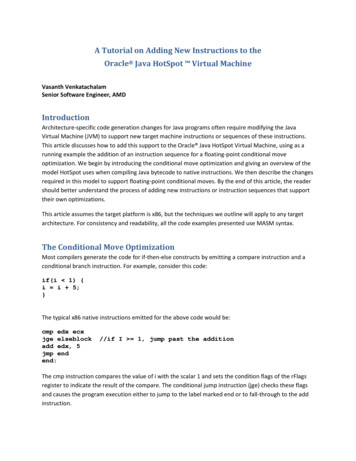
Transcription
A Tutorial on Adding New Instructions to theOracle Java HotSpot Virtual MachineVasanth VenkatachalamSenior Software Engineer, AMDIntroductionArchitecture-specific code generation changes for Java programs often require modifying the JavaVirtual Machine (JVM) to support new target machine instructions or sequences of these instructions.This article discusses how to add this support to the Oracle Java HotSpot Virtual Machine, using as arunning example the addition of an instruction sequence for a floating-point conditional moveoptimization. We begin by introducing the conditional move optimization and giving an overview of themodel HotSpot uses when compiling Java bytecode to native instructions. We then describe the changesrequired in this model to support floating-point conditional moves. By the end of this article, the readershould better understand the process of adding new instructions or instruction sequences that supporttheir own optimizations.This article assumes the target platform is x86, but the techniques we outline will apply to any targetarchitecture. For consistency and readability, all the code examples presented use MASM syntax.The Conditional Move OptimizationMost compilers generate the code for if-then-else constructs by emitting a compare instruction and aconditional branch instruction. For example, consider this code:if(i 1) {i i 5;}The typical x86 native instructions emitted for the above code would be:cmp edx ecxjge elseblockadd edx, 5jmp endend://if I 1, jump past the additionThe cmp instruction compares the value of i with the scalar 1 and sets the condition flags of the rFlagsregister to indicate the result of the compare. The conditional jump instruction (jge) checks these flagsand causes the program execution either to jump to the label marked end or to fall-through to the addinstruction.
In cases in which an if construct has no else block, a compiler can sometimes emit a conditional moveinstruction instead of a conditional branch. The integer conditional move instruction on x86 hardwareconditionally copies a value from a register or memory location into a register, based on the conditionflags in the rFlags register, which were previously set by a compare instruction.If we were to convert this code to use conditional moves instead of branches, it would become:mov eax, edxadd eax, 5cmp edx ecxcmovge edx, eax //conditionally move the result of the addition intoedxThe advantage of the conditional move optimization is that it removes branches from the compiledcode. The latest JDK-7 release of HotSpot emits integer cmoves for x86/x64 architectures but notfloating-point cmoves. This is because the floating-point cmove instruction is a new feature on the AMDFamily 15h processors, which have yet to be released. In the following sections, we will examine howHotSpot implements integer cmoves. This will give us insight into the changes needed to add support forfloating-point cmoves.Overview of the HotSpot Compilation ProcessWhen compiling a Java method, HotSpot first parses the bytecodes and creates an intermediaterepresentation (IR), which represents the instructions in the method in the form of an abstract syntaxtree. The nodes in the tree represent operations (e.g., addition, multiplication, cmove) and their childrenrepresent the inputs to those operations. For example, we can visually represent the sub-treecorresponding to a basic “reg-to-reg” form of the integer addition operation:AddIrRegIrRegIrFlagsregThe addition operation takes three inputs, a source integer register (rRegI), a second source integerregister (rRegI), and the rFlags register (rFlagsreg), which would be written to in the case of overflow.We can also represent more complex operations in the IR. For example, the IR may contain a sub-treethat corresponds to the addition of a value in a register with the previous result of an integer addition,visually represented as:
AddIrRegIrFlagsregAddIrRegIrRegIrFlagsregThe root AddI node contains three children, as in the first example, but the second child is another AddInode.HotSpot traverses the IR and maps specific sub-trees to sequences of native instructions. In this manner,it selects the instructions to emit for the target platform. However, there are many ways to select theseinstructions. Consider this sub-tree, which represents the result of adding the value in a register to theresult of a agsregSuppose there were an instruction AddMul that multiplied the values in two input registers and addedthe result to a third register, updating rFlags as necessary. Then there would be two ways to generatenative code for this syntax tree. The first would be to generate a separate mul instruction for the MulInode, and a separate add instruction for the AddI node. We can visually represent this strategy formapping native instructions to this IR sub-tree:
s mapping eventually would generate this sequence of native instructions:mul dst, src1 //dst dst * src1add dst, src2 //dst dst src2An alternate approach would be to map the whole sub-tree to our fictitious AddMul rFlagsregThis alternate mapping would generate these native instructions:AddMul dst, src1, src2 // dst src1 * dst src2The AddMul instruction in this example is hypothetical. However, our example shows there are multipleways to map IR nodes to sequences of native instructions. How does HotSpot decide which instructionsequence to emit in these cases? The answer lies in the architecture description language file (AD).The AD file defines the native instructions the HotSpot code generator can emit, and it specifies for eachinstruction the IR sub-tree for which that instruction (or instruction sequence) would be a possible
candidate. In addition, it assigns every candidate instruction sequence a cost that HotSpot uses todetermine which instruction sequences to emit in cases when multiple instruction sequences match thesame IR sub-tree.The Architecture Description FileAdding new instructions to HotSpot is a two-step process. The first step is defining the IR pattern (alsocalled a match rule) for which we want to generate the new instruction (or instruction sequence) anddefining the instruction (or instruction sequences) in the AD file. The second step is extending theHotSpot assembler with the routines that encode the new instruction(s). Examining this process forinteger cmoves will give us insight into how we can do it for floating-point cmoves.For x86 code, there are two AD files located under the directory src/cpu/x86/vm. The file x86 32.adapplies to 32-bit platforms and x86 64.ad applies to 64-bit platforms. For the purposes of this example,we will look at the section of the x86 64.ad file that defines the version of the integer cmove instructionthat takes two integer registers as operands.// Conditional moveinstruct cmovI reg(rRegI dst, rRegI src, rFlagsReg cr, cmpOp cop)%{match(Set dst (CMoveI (Binary cop cr) (Binary dst src)));ins cost(200);format %{ "cmovl cop dst, src\t# signed, int" %}opcode(0x0F, 0x40);ins encode(REX reg reg(dst, src), enc cmov(cop), reg reg(dst, src));ins pipe(pipe cmov reg);%}The instruct construct defines a new instruction (or instruction sequence), specifies the conditions underwhich the instruction (or instruction sequence) should be emitted and calls routines that encode theinstruction (or instruction sequence).The first line, instruct cmovI reg(rRegI dst, rRegI src, rFlagsReg cr, cmpOp cop), defines the name of thenew instruction sequence (cmovI reg) and lists any parameters that will be used in the body of thisinstruct. The actual name can be arbitrary, but it is a good practice to choose names that reflect thenature of the new instruction(s). In this case, the parameters are a source register (src) and destinationregister (dst), both of which store integer values (hence the regI), the rFlags register (cr) that conditionalmoves require, and a bool operator (cop) that specifies the condition code for the conditional move(e.g., move if greater-than, move if less-than).The line ins cost(200) specifies the cost of generating this instruction. As we have mentioned, the sameIR sub-tree can have multiple code generation candidates. When this is the case, HotSpot chooses thecandidate with the lowest cost based on the value entered in this line. For the instructions we added toHotSpot, the values chosen for ins cost are just estimates that guarantee that HotSpot will executethese instructions. These values may not be identical to the actual cost (in cycles) of the instructions.
The format section, format %{ "cmovl cop dst, src\t# signed, int" %} , generates the printing functionsused when the command line flag –XX: PrintOptoAssembly is enabled. This option allows us to see whatinstructions the JVM is emitting.There are many ways to specify the encoding for an instruction sequence. In this example, theopcode( ) line specifies the opcode that should be emitted and the ins encode( ) line is encoding theparameters for the instruction, which in this case include the register arguments and the condition codefor the comparison operator cmpOp.The ins encode construct has two formats. In the first format, used in this example, ins encode isfollowed by a list of comma-separated arguments called encoding classes enclosed in parenthesis. Theseencoding classes are macros that call assembler routines. This is no longer the preferred way of usingins encode. The preferred format is the block format:ins encode %{stmt1;stmt2;stmt3;.stmtn;%}Where stmt1-stmtn are calls to assembler routines. For example, in the definition of the load byteinstruction, the ins encode line is:ins encode %{movsbl( dst Register, mem Address); // Call to assemblerroutine that encodes movsbl instruction%}Similarly, we have used the block format of ins encode to encode our new instruction sequence forfloating-point conditional moves. To summarize, all of the work for encoding an instruction shouldhappen via calls to assembler routines inside an ins encode %{ %} block, instead of using encodingclasses.Finally, the line match(Set dst (CMoveI (Binary cop cr) (Binary dst src))) is called a match rule. It specifiesthe IR sub-tree for which the integer cmove instruction is a possible code generation candidate. The bestway to understand how the match rule works is to study its visual representation as an in-order tree:
This rule says that for IR sub-trees that match the right-hand child of the Set node (highlighted above),the sequence of native instructions defined by the cmovI reg instruct are a candidate code generationchoice.In more detail: If the IR contains a sub-tree that has a CMoveI node, whose left and right children are bothBinary nodes, and The left-hand Binary node has a left-child that is a cmpOp node and a right-child that is anrFlagsReg node, and The right-hand Binary node has a left-child that is an rRegI node and a right-child that is an rRegInode, then The instruction sequence defined by the cmovI reg instruct is one of the candidate instructionsequences that can be generated for this sub-tree.The right-hand child of the Set node is always the source of the match rule; that is, it specifies the IR subtrees that could match this rule, and thus the sub-trees for which this sequence of native instructions isa possible candidate. The left-hand child is the destination of the match rule. It says the result of aCMoveI operation would be stored in a node of type rRegI (an integer register).The Binary nodes are an implementation detail used to transform nodes that require more than twoinputs into a binary tree prior to matching, because the IR matcher can only match binary trees. In this
example, the CMoveI node essentially requires four inputs (cmpOp, rFlagsReg, rRegI, rRegI). The Binarynodes allow formation of a tree that takes two inputs instead of four.These observations allow us to construct more complex match rules. For example, suppose we want todefine a new instruction sequence that should be emitted for any integer addition operation in whichone of the source registers is the output of a previously defined CMoveI operation. The first step inderiving the match rule is to look at the match rule for a generic addition operation:SetrRegIAddIrRegIrRegIrFlagsregWe can then derive the match rule for our new addition operation by replacing the second rRegIparameter to AddI (highlighted) with the source of the CMoveI match rule:
FlagsRegrRegIrRegIIn AD syntax, this new match rule would be expressed as:match (Set dst (AddI src (CMoveI (Binary (cop cr) Binary (cmove dest cmove source) ))))where the variables src, dst, cmove source and cmove dest have previously been defined in the list ofparameters to the instruct.In this manner, we can define more complex instruction sequences that depend on the results ofpreviously defined instructions. This is an important concept we will use when defining floating-pointconditional moves.How HotSpot Treats Floating-point Conditional MovesTo decide what enhancements are needed to support floating-point cmoves, we should first see whatHotSpot does in cases in which it would emit floating-point cmoves. Consider the following program:public class cmovd {public static double test(double f) {if(f 10.78) {f 10;}
return f;}public static void main(String[] args) {double f 5.3;f test(f);}The compiled code HotSpot generates for the test( ) routine in the above program is:pushsubnopmovsdmovsd%rbp%rsp, 0x10%xmm1,%xmm2 ,82(%rip)82(%rip)// Load 10 in xmm1// Load 10.78 in xmm2ucomisd %xmm2, %xmm0jbe0x00002aaaab6eda00movapd %xmm0,%xmm1add%rsp, 0x10pop%rbp// Compare f to 10.78// If f 10.78 fall through// Set f 10HotSpot is em
A Tutorial on Adding New Instructions to the Oracle . This is because the floating-point cmove instruction is a new feature on the AMD Family 15h processors, which have yet to be released. In the following sections, we will examine how HotSpot implements integer cmoves. This will give us insight into the changes needed to add support for floating-point cmoves. Overview of the HotSpot .
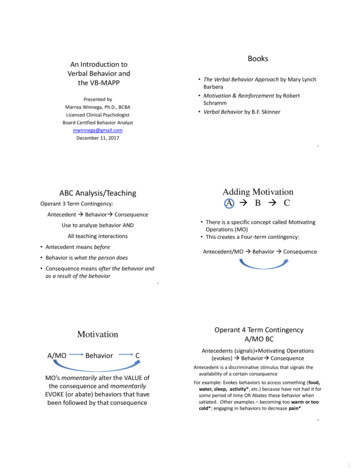
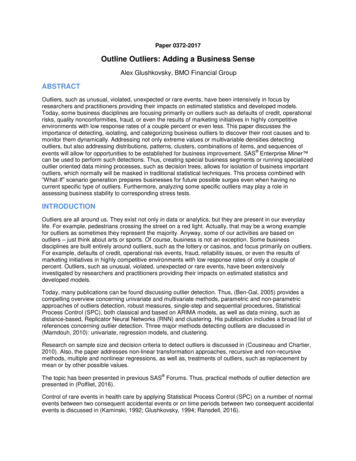
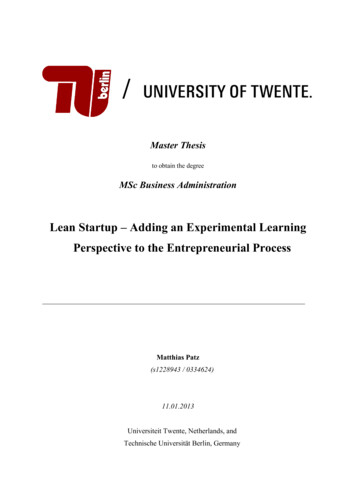
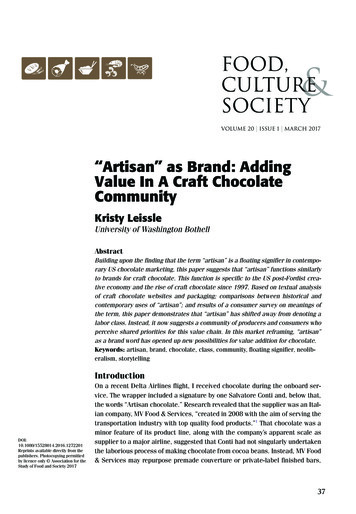


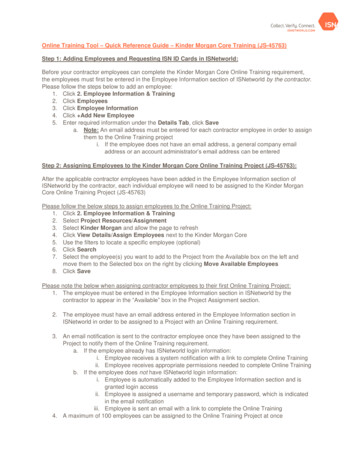
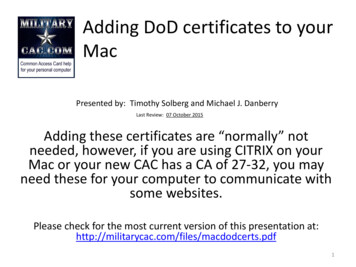

![Unreal Engine 4 Tutorial Blueprint Tutorial [1] Basic .](/img/5/ue4-blueprints-tutorial-2018.jpg)
